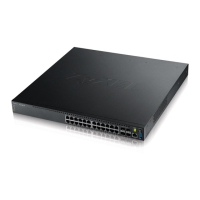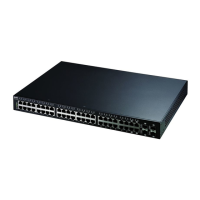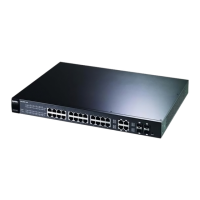Chapter 22 VLAN Stacking
GS3700/XGS3700 Series User’s Guide
223
The following table describes the labels in this screen.
22.4.1 Port-based Q-in-Q
Port-based Q-in-Q lets the Switch treat all frames received on the same port as the same VLAN
flows and add the same outer VLAN tag to them, even they have different customer VLAN IDs.
Click Port-based QinQ in the Advanced Application > VLAN Stacking screen to display the
screen as shown.
Table 96 Advanced Application > VLAN Stacking
LABEL DESCRIPTION
Active Select this checkbox to enable VLAN stacking on the Switch.
Slot
(Stacking
mode)
This field appears only in stacking mode. Click the drop-down list to choose the slot number of
the Switch in a stack.
Port
(Standalo
ne or
stacking
mode)
This field displays the port number. In stacking mode, the first box field is the slot ID and the
second field is the port number.
* Settings in this row apply to all ports.
Use this row only if you want to make some settings the same for all ports. Use this row first to
set the common settings and then make adjustments on a port-by-port basis.
Note: Changes in this row are copied to all the ports as soon as you make them.
Role Select Normal to have the Switch ignore fram es received ( or t ransm itted) on this port with VLAN
stacking tags. Anything you configure in SPVI D and Priority of the Port-based QinQ or the
Selective QinQ screen are ignored.
Select Access Port to have the Switch add the SP TPID tag to all incoming frames received on
this port. Select Access Port for ingress ports at the edge of the service provider's network.
Select Tunnel Port (available for Gigabit ports only) for egress ports at the edge of the service
provider's network. Select Tunnel Port to have the Switch add the Tunnel TPI D tag to all
outgoing frames sent on this port.
In order to support VLAN stacking on a port, the port must be able to allow frames of 1526 Bytes
(1522 Bytes + 4 Bytes for the second tag) to pass through it.
Tunnel
TPID
TPID is a standard Ethernet type code identifying the frame and indicates whether the frame
carries IEEE 802.1Q tag information. Enter a four-digit hexadecimal number from 0000 to FFFF
that the Switch adds in the outer VLAN tag of the frames sent on the tunnel port(s). The Switch
also uses this to check if the received frames are double-tagged.
The value of this field is 0x8100 as defined in IEEE 802.1Q. If the Switch needs to communicate
with other vendors’ devices, they should use the same TPI D.
Note: You can define up to four different tunnel TPIDs (including 8100) in this screen at a time.
Apply Click Apply to save your changes to the Switch’s run-time memory. The Switch loses these
changes if it is turned off or loses power, so use the Save link on the top navigation panel to save
your changes to the non-volatile memory when you are done configuring.
Cancel Click Cancel to begin configuring this screen afresh.

